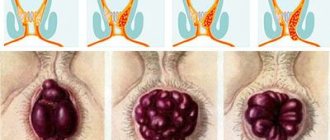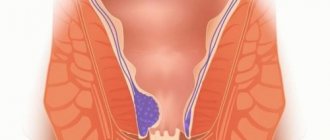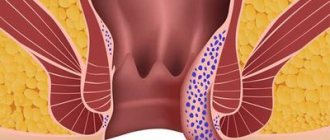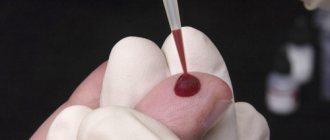Home » Hemorrhoids » Stages of hemorrhoids
Sign up for a consultation with a proctologist for the treatment of hemorrhoids for 3,500 rubles and receive a treatment prescription within 30 minutes for 1 appointment
Find out what day you need to make an appointment to get a consultation without a queue.
Experience 44 years 73 operations per month 876 operations per year 171 reviews Author of 73 scientific papers Has 9 patents 6,818 requests per month
Call
Hemorrhoids are a common proctological disease, which is characterized by dilation of blood vessels in the anus. Vessels are deformed and injured. A violation of the functionality of internal organs is diagnosed. The disease is developing rapidly, so you should contact a proctologist as soon as possible to make a diagnosis and begin treatment.
According to medical statistics, hemorrhoids are diagnosed in every fourth patient. The disease develops in both young and elderly people. With age-related changes, the functioning of internal organs and the digestive tract is disrupted. In most cases, patients turn to a proctologist only when the condition has worsened and their usual way of life has been disrupted.
For effective treatment, suppositories, ointments and gels, and traditional medicine are used, which are also effective for hemorrhoids. Procedures are carried out after which the tumors die. In the final stages, drug treatment does not make sense. Surgery will be required to prevent the disease from developing. There are four degrees of hemorrhoids, which carry different dangers.
Hemorrhoids
Hemorrhoids are varicose veins of the intestines. The human anus is considered the entrance to the rectum. The length of the intestinal section is 14–18 cm. Hemorrhoids are located around the anus.
The hemorrhoid consists of mucous membranes, cavities, veins and arteries, which are interconnected. When pathological expansion of the veins is observed, hemorrhoids develop. Based on location, hemorrhoids are divided into internal, external and combined.
| Internal view | Appearance | Combined view |
| It is characterized by a pathological enlargement of hemorrhoids in the rectum. It is difficult to diagnose in the early stages. | External hemorrhoids are easier to identify even during the initial examination and palpation. Hemorrhoids are located under the soft tissue around the anus. | Accompanied by a violation of the outflow of blood in both external and internal hemorrhoids. The rehabilitation period will be longer than with the above types of pathology. |
By nature, proctologists distinguish acute and chronic forms:
- The acute form of hemorrhoids is accompanied by bleeding from the anus, severe pain, and an increase in the size of the hemorrhoids.
- The chronic form or remission is practically asymptomatic and has no manifestations.
Each form or phase of proctological disease requires special attention and an individual approach.
Hemorrhoids: causes of occurrence
Although the presence of hemorrhoidal plexuses is part of the normal anatomy of the rectum, if the nodes become inflamed, increase in size, and blood stagnates in them, a disease develops - hemorrhoids. Changes occur gradually, starting from barely noticeable and reaching severe and pronounced. Symptoms of hemorrhoids occur when pressure increases in the small vessels supplying the rectum and anus, causing the veins and plexuses to swell and fill with blood. This leads to an increase in the size of the nodes, which contributes to the appearance of symptoms of external or internal hemorrhoids. Increased pressure in the veins and the development of pathology can be caused by many factors, and the causes of hemorrhoids in women or men may vary. Common risk factors include:
- Lack of fiber-rich foods in the diet, which causes hardening of the stool. Difficulty during bowel movements causes a person to strain and strain, which increases the pressure in the blood vessels of the anus.
- Prolonged sitting on the toilet, which can increase the pressure in the blood vessels of hemorrhoids.
- Obesity;
- Diarrhea – both acute and chronic.
- Colon cancer or previous rectal surgery.
For women, an additional cause of hemorrhoids that affects treatment is pregnancy. Carrying a baby is associated with swelling and enlargement of hemorrhoids, which most likely occurs due to the increased pressure of the enlarged uterus on the rectum and anus. In addition, hormonal changes during pregnancy can weaken the muscles that support the rectum and anus, which form the tone of the veins.
Hemorrhoids 1st degree
The initial stage of hemorrhoids is asymptomatic and does not bother the patient. In some cases, itching and burning appears in the anus. Impurities of blood, pus and mucus form in the stool. Drops of blood are visible on the toilet paper. At the early stage of proctological disease, patients rarely seek medical help. It is extremely important to contact a medical specialist in time to begin treatment at the first stage and avoid complications.
Advanced forms of the disease are much more difficult to cure. At stage 1 of hemorrhoids, the patient is prescribed rectal suppositories or medications. They eliminate the inflammatory process, kill harmful bacteria, and improve blood flow in the vessels. Traditional medicine is used. Potato suppositories will help improve blood circulation in the anus and make bowel movements easier.
Hemorrhoids 2nd degree
This stage is accompanied by pain during defecation. Exertion and physical stress also occur with discomfort. Bloody discharge from the anus appears on the underwear. The patient notices bloody clots even in the absence of bowel movements and in a calm state. After a bowel movement, you feel like you have an empty bowel.
Stage 2 hemorrhoids require special attention and urgent treatment. If the patient misses time, then conservative treatment will not help cure the disease in the future. The proctologist prescribes hemostatic drugs and rectal suppositories. Minimally invasive treatment methods are carried out, including sclerotherapy using special injections. The injection is injected into the base of the blood clot and promotes its death.
Infrared coagulation is also performed. Accompanied by cauterization of hemorrhoids using laser radiation. In case of complications, the patient is referred for latex ligation. The blood vessels of the anus are compressed with a latex ring, after which the pathological neoplasm dies and disappears. There is no blood flow, so the node comes out of the anus.
Traditional medicine is also effective in this case. The patient is given microenemas of rosehip or sea buckthorn oil. The doctor prescribes baths with a decoction of chamomile, oak bark, birch, and potassium permanganate. A special anti-hemorrhoidal collection is also used.
Hemorrhoids: types, stages, treatment
Shlosser Kirill Vladimirovich
Surgeon, Proctologist
April 30, 2021
Hemorrhoids are a pathological expansion of cavernous (that is, cavernous or spongy in structure) vascular plexuses located in the anus, with the formation of external and/or internal nodes.
Causes of hemorrhoids
- A lifestyle associated with prolonged static loads: hemorrhoids are an “occupational” disease of drivers, office workers, security guards, etc.
- Excessive physical activity, heavy lifting, sudden tension.
- Excessive consumption of alcohol, spicy and pickled foods.
- Constipation, straining with difficulty defecating (defecation).
- Pregnancy and childbirth.
- Heredity.
Symptoms of hemorrhoids
- Discomfort or pain in the anus.
- Sensation of a foreign body in the anal canal.
- Discharge of blood during bowel movements, blood in the stool.
- Nodes in the anal area.
Classification of the disease
Acute hemorrhoids are thrombosis of hemorrhoids. The external manifestation is a dense, painful external or internal bluish-colored node filled with a blood clot.
Acute hemorrhoids are divided into three degrees of severity:
I degree – Thrombosis of external or internal hemorrhoids without an inflammatory process.
II degree – Thrombosis, complicated by inflammation of hemorrhoids.
III degree – Thrombosis of hemorrhoids, complicated by inflammation of the subcutaneous tissue in the perianal area.
Therapeutic tactics involve both complex conservative treatment and surgical treatment.
The indication for surgical treatment is acute thrombosis of the hemorrhoid. In the early stages of the disease, optimally up to 72 hours, thrombectomy is indicated - removal of thrombotic masses. Performed on an outpatient basis. The operation leads to a significant reduction in treatment time.
In later stages, either removal of the thrombosed node or conservative treatment followed by planned surgery is possible. Hospitalization is indicated for stage III of the disease, when the inflammatory process spreads to the surrounding tissues of the perianal region and anal canal.
Stages of disease development
Chronic hemorrhoids are divided into four stages.
Characteristic symptoms:
Stage I – Periodic bleeding from the rectum without prolapse of hemorrhoids. The method of treatment is conservative therapy.
Stage II - Hemorrhoids fall out during defecation, but are reduced on their own. There may or may not be bleeding. It is also possible for nodes to fall out during intense physical activity.
The second stage combines conservative treatment and minimally invasive proctological manipulations, which are carried out by Medical specialists in an outpatient setting.
Stage III – Manual assistance is required to reduce the nodes into the anal canal. Bleeding becomes more profuse, and periodic inflammation of the hemorrhoids is observed.
Treatment is surgical. The operations are performed by proctological surgeons at the Medical Outpatient Surgery Center.
IV – Hemorrhoids are constantly in a prolapsed state. This is the most difficult stage. Prolapse occurs even with the slightest stress: change in body position, coughing, release of gas from the intestines. The walls of the node are constantly injured and inflamed.
Only surgical treatment is indicated.
Treatment of hemorrhoids
Methods for diagnosing proctological diseases
- During an external examination, the doctor pays attention to the shape of the anus, its gaping, scar changes or deformations, fistulous openings, the condition of the skin and mucous membrane of the anal canal when straightening the folds. It determines the severity of external hemorrhoids, the stage of the disease, the degree of bleeding and prolapse of the nodes, the possibility of their independent reduction into the anal canal, and evaluates the anal reflex.
- Digital examination helps determine the tone of the sphincter, the presence of neoplasms, mucosal defects and the degree of their pain.
- Anoscopy is performed using a special disposable anoscope device, which allows you to examine the inner surface of the rectum and anal canal up to 10 cm. The procedure is painless, preparation is not required. Using anoscopy, a proctologist can assess the condition of internal hemorrhoids, the presence of inflammatory changes in the mucosa, detect anal canal polyps, mucosal defects, blood clots and possible sources of bleeding.
- Sigmoidoscopy is an examination of the rectum and distal sigmoid colon up to 25 cm using a special endoscopic device that allows you to assess the condition of these sections from the internal lumen of the intestine.
Thanks to a complex of diagnostic tests, a specialist can identify not only hemorrhoids, but also concomitant diseases.
Conservative treatment of hemorrhoids
The therapy is based on a specialized diet aimed at normalizing stool. The patient's diet should include foods rich in plant fiber and plenty of liquid. The doctor also prescribes medications that stimulate bowel movements.
To relieve inflammation, ointments, creams and suppositories with an anti-inflammatory combined effect are used. Therapy is supplemented by taking phlebotonics - drugs that increase the tone of the vascular wall.
In case of severe bleeding, local and general hemostatic (hemostatic) agents are prescribed.
For the conservative treatment of hemorrhoidal thrombosis, combined local agents with analgesic, anti-inflammatory, absorbable, and decongestant effects are used.
Minimally invasive methods of surgical treatment of hemorrhoids
- Sclerosation of hemorrhoids
Indications for surgery are chronic hemorrhoids of stages I–II, accompanied by bleeding.
A special substance – sclerosant – is injected into the lumen of the hemorrhoid using the thinnest injection needles. This drug glues the walls of the vessels inside the node, preventing further progression of the pathology. The operation is performed in an outpatient clinic.
Contraindications:
– Thrombosis of hemorrhoids
– Paraproctitis
– Anal fissure
- Ligation of internal hemorrhoids
Indicated for chronic hemorrhoids of degrees II and III, if the nodes are located separately from each other and have clearly defined boundaries.
The operation is performed in an outpatient setting. A latex ring (ligature) is placed on the base of the internal node, the nutrition of the node is disrupted and it is rejected along with the ligature after 7-10 days. Ligation of several nodes at once can cause pain, low blood pressure and bradycardia in the patient, so the procedure is usually performed at 2-3 week intervals.
Surgical treatment methods performed at the Medical Center
- Laser vaporization of hemorrhoids
It is performed for chronic hemorrhoids of stages II and III. Also suitable for the treatment of small external hemorrhoids. The operation is performed using a Milon-Lakhta surgical laser, which destroys (evaporates) fluid-rich hemorrhoidal tissue, while preserving the mucous membrane. The light guide is inserted into the lumen of the internal hemorrhoid through a small 1-2 mm puncture of the anoderm. The manipulations are performed under general anesthesia in the Outpatient Surgery Center of our clinic.
Advantages of the technique:
– Reduced operation time.
– Significant reduction in pain intensity in the postoperative period compared to classic hemorrhoidectomy.
– Significant reduction in the healing time of surgical wounds and punctures.
– More comfortable course of the postoperative period and rapid recovery of work capacity.
Contraindications:
– Stage IV hemorrhoids
– Purulent and oncological diseases of the rectum
- The Milligan-Morgan hemorrhoidectomy operation is indicated for stages III–IV of chronic hemorrhoids
There are two main types of hemorrhoidectomy: open and closed.
Open surgery is performed under general anesthesia in the operating room. The doctor alternately stitches and ties the vascular legs of the nodes and then removes the external and internal hemorrhoids. Postoperative wounds are not sutured. Next, the surgical site is injected with a local anesthetic, and an absorbable tampon with an anesthetic is placed in the anal canal.
A closed operation is performed in the same way as an open operation, but after removing the nodes, the wounds of the anal canal are sutured with absorbable suture material.
Also, a similar operation is performed using a high-frequency ligation device LigaSure. It is considered open. LigaSure allows the operation to be performed almost bloodlessly, since the device automatically coagulates (seals) large vascular formations that make up the hemorrhoid. The nodes are excised down to the vascular pedicle, and after “welding” the pedicle, they are finally removed.
Advantages of the technique:
– The operation goes faster.
– Reduced blood loss during surgery.
– The risk of bleeding in the postoperative period is reduced.
– Recovery after surgery is faster.
Postoperative treatment of hemorrhoids takes place in an outpatient clinic. The proctologist observes, makes dressings, gives nutritional recommendations and prescribes medications for the recovery period.
Experienced medical proctologists will be happy to help you solve your problems.
Hemorrhoids 3rd degree
This stage is considered dangerous to human health. Surgical intervention rather than conservative treatment is used. The operation is performed if drug therapy does not bring the desired effect. The size of hemorrhoids is rapidly increasing. The formations fall out of the anus, the patient cannot put them back inside without the help of a medical specialist.
The help of a qualified doctor is required, since repositioning of the nodes inward is required after defecation. This procedure will help avoid discomfort and pain, and not cure the pathology. The use of medications at stage 3 of hemorrhoids is effective only to alleviate the condition and eliminate pain. Treatment of third-degree hemorrhoids with folk remedies makes no sense.
Hemorrhoids grow daily, so invasive treatment methods are used. If you avoid treatment and visiting a proctologist, third-degree hemorrhoids develop into rectal cancer and pose a serious threat to the health and life of the patient.
Infrared photocoagulation method
In this case, treatment of the hemorrhoid is carried out by cauterizing it at several points at the base (from two to six). The duration of the session is very short, only 10-15 seconds.
The patient does not experience any particular discomfort or pain. During the procedure, he lies on his side on the couch with his knees pressed to his chest. His body is covered with special proctological underwear, in which a hole is left for inserting an anoscope. This is an important point, because eliminates the tightness that occurs in some patients.
Point cauterization of the base of the hemorrhoidal node deprives it of adequate nutrition, which subsequently leads to the complete death of the node. To prevent pain during the procedure, the patient may be given local anesthesia using special gels.
Infrared photocoagulation is a gentle technique that does not cause excessive bleeding. No sick leave is required, the recovery period is minimized.
Hemorrhoids 4 degrees
The patient's condition is rapidly deteriorating. Stage 4 hemorrhoids require immediate surgical intervention and removal of hemorrhoids. The advanced disease is characterized by pain when walking and even while sitting. Reduction of tumors into the anus is impossible.
Bleeding becomes profuse. As a result, anemia or anemia is diagnosed. The patient feels severe weakness, loss of strength, and lack of appetite. Blood clots form in the cavernous veins, which negatively affect the blood circulation process. Hemorrhoids become inflamed, thereby provoking the appearance of suppuration and necrosis, dead areas of soft tissue. Harmful bacteria spread throughout the body and worsen the condition.
Treatment methods
The following methods are used in the treatment of hemorrhoids:
| Hemorrhoid stage | Treatment |
| First | Creams, gels, rectal suppositories, drugs, sclerotherapy, photocoagulation, Bicap diathermocoagulation |
| Second | Hardening of nodes, medications, photocoagulation, latex ring ligation, thermal probe, Ultroid current |
| Third | Drug therapy, latex ring ligation, Ultroid current, hemorrhoidectomy |
| Fourth | Hemorrhoidectomy, phlebotropic drugs |
In the early stages of hemorrhoids, traditional medicine using herbs, decoctions and mixtures is also used.
Reasons for development
Why do hemorrhoids develop? In some cases, the disease appears due to a genetic predisposition. In people who are prone to the appearance of hemorrhoidal cones, the blood vessels in utero are weak, worn out, and intra-abdominal pressure increases. Ultimately, the blood stagnates in the body, and the cavity expands. The influx of arterial blood exceeds the outflow of venous blood, which should not be the case.
There are other reasons for the development of the disease, including:
- A low-active lifestyle includes office workers, drivers, and salespeople at risk.
- Excessive physical exertion, work associated with lifting weights, playing professional sports.
- Disrupted daily routine and lack of adequate sleep.
- Poor nutrition, excessive consumption of baked goods, spicy and salty foods.
- Alcohol abuse: Excessive consumption of alcoholic beverages increases intra-abdominal pressure.
- Pathologies associated with bowel movement.
- Malignant and benign formations.
- Pregnancy during gestation produces strong pressure on the abdominal organs, the uterus puts pressure on the internal organs, and blood volume increases.
In young children, hemorrhoids are diagnosed much less frequently. The cause is considered to be congenital dilatation of the cavernous veins. The child often cries, as a result of which the blood flow to the cavernous formations increases. Stagnation and blood clots form. Also, infants develop hemorrhoids if they often sit on the potty, thereby trying to push.
In adolescence, proctological disease develops as a result of frequent masturbation. Blood circulation is disrupted in the pelvic organs. The disease is most common among older people. Physical activity in old age gradually decreases, and a sedentary lifestyle appears. Other diseases of the digestive tract are also diagnosed. Patients are forced to take a large number of medications, disrupting intestinal motility. Side effects of the drugs provoke poor circulation in the pelvic organs and an increase in hemorrhoids.
Disease prevention
Even in the absence of symptoms, it is extremely important to follow preventive measures to avoid the appearance of hemorrhoidal cones and an increase in their size. To do this, you should visit a proctologist every six months for diagnostic tests. At home, it is recommended to do baths and microenemas, and use rectal suppositories, which have a positive effect on the microflora and the condition of soft tissues. In a hospital setting, cauterization of blood vessels is performed.
It is important to follow a diet, include fermented milk products, fruits and vegetables in your diet, and drink plenty of clean water. To improve the functioning of the esophagus, avoid excessive consumption of caffeine and alcoholic beverages. Spicy seasonings and sauces irritate the intestinal mucosa.
Every day you need to walk in the fresh air and do physical exercise. This prevention is especially important for people who lead a sedentary lifestyle. Squats will help relax your muscles and improve blood flow in your veins and arteries.
Proctologists advise limiting heavy lifting and excessive physical activity. Try to minimize muscle tension. To activate blood circulation in the anus and avoid enlargement of hemorrhoids, you can rinse the anus with cool water using herbal remedies.
To avoid irritating the soft tissue of the anus, you should purchase damp toilet paper. Only with a timely visit to a proctologist can complications and the development of proctological diseases be avoided. To make an appointment, call the number listed on the official website. An employee of the private medical clinic “Proctologist 81” will call you back and confirm the selected time. Prices for diagnostic tests and procedures are posted on the website. The cost depends on the stage of the disease and the presence of concomitant pathologies.
Prevention of hemorrhoids
Prevention is the most effective treatment. Diet and adequate fluid intake are very important to maintain normal bowel movements. Symptoms of hemorrhoids can occur with the passage of hard stools and constipation, as well as with diarrhea and frequent bowel movements. People with constipation may need a high-fiber diet, adequate fluids, and stool softeners. Those who have excessively frequent bowel movements may need antidiarrheal medications and dietary adjustments. These preventive measures reduce the strain required to have a bowel movement, thereby reducing the pressure in the blood vessels to prevent swelling.
The SM-Clinic Surgery Center provides services for prompt diagnosis and effective treatment of hemorrhoids using non-surgical methods and surgical techniques. Our patients recover within 24 hours in a comfortable hospital setting and quickly return to their normal lifestyle. Other treatment methods are also used, depending on the stage and type of disease. Advanced equipment is used for diagnostics, ensuring accuracy and speed of obtaining results.








